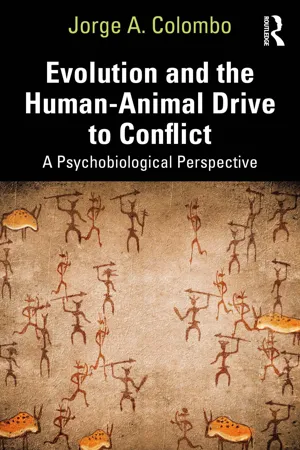
Evolution and the Human-Animal Drive to Conflict
A Psychobiological Perspective
- 232 pages
- English
- ePUB (mobile friendly)
- Available on iOS & Android
About this book
Evolution and the Human-Animal Drive to Conflict examines how fundamental, universal animal drives, such as dominance/prevalence, survival, kinship, and "profit" (greed, advantage, whether of material or social nature), provide the basis for the evolutionary trap that promotes the unstable, conflictive, dominant-prone individual and group human behaviours.
Examining this behavioural tension, this book argues that while these innate features set up behaviours that lean towards aggression influenced by social inequalities, the means implemented to defuse them resort to emotional and intellectual strategies that sponsor fanaticism and often reproduce the very same behaviours they intend to defuse. In addressing these concerns, the book argues that we should enhance our resources to promote solidarity, accept cultural differences, deter expansionist and uncontrolled profit drives, and achieve collective access towards knowledge and progress in living conditions. This entails promoting the redistribution of resources and creative labour access and avoiding policies that generate a fragmented world with collective and individual development disparities that invite and encourage dominance behaviours. This resource redistribution asserts that it is necessary to reformulate the global set of human priorities towards increased access to better living conditions, cognitive enhancement, a more amiable interaction with the ecosystem and non-aggressive cultural differences, promote universal access to knowledge, and enhance creativity and cultural convivence. These behavioural changes entail partial derangement of our ancestral animal drives camouflaged under different cultural profiles until the species succeeds in replacing the dominance of basic animal drives with prosocial, collective ones. Though it entails a formidable task of confronting financial, military, and religious powers and cultural inertias – human history is also a challenging, continuous experience in these domains – for the sake of our own self-identity and self-evaluation, we should reject any suggestion of not continuing embracing slowly constructing collective utopias channelled towards improving individual and collective freedom and creativeness.
This book will interest academics and students in social, cognitive, and evolutionary psychology, the neurosciences, palaeoanthropology, philosophy, and anthropology.
Frequently asked questions
- Essential is ideal for learners and professionals who enjoy exploring a wide range of subjects. Access the Essential Library with 800,000+ trusted titles and best-sellers across business, personal growth, and the humanities. Includes unlimited reading time and Standard Read Aloud voice.
- Complete: Perfect for advanced learners and researchers needing full, unrestricted access. Unlock 1.4M+ books across hundreds of subjects, including academic and specialized titles. The Complete Plan also includes advanced features like Premium Read Aloud and Research Assistant.
Please note we cannot support devices running on iOS 13 and Android 7 or earlier. Learn more about using the app.
Information
Table of contents
- Cover
- Half Title
- Title Page
- Copyright Page
- Dedication
- Table of Contents
- Acknowledgement
- Foreword
- 1 Species and Cultural Evolution
- 2 Evolution, Biological Inertias, Violence, and the Evolutionary Trap
- 3 Gene-Culture Interactions
- 4 Organism-Environment as an Integrated Dynamic System
- 5 Social Dominance and Inequalities
- 6 Neurobiological and Cultural Tectonic Plate Friction
- 7 Socio-cultural Behavioural Conditioners. The Evolutionary Trap
- 8 The State of the World
- 9 Dominance and the Human Development of the Evolutionary Trap
- 10 Waste Management and Quality of Life
- 11 Wealth Inequalities and Social Dominance
- 12 Dr Jekyll and Mr Hyde Embedded in Our Human History
- 13 Homo sapiens: a Janus-Faced Species or Two Coexisting Varieties?
- Appendix
- References
- Index